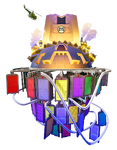- "Hey! Good morning, Monstropolis. It's now five after the hour of 6:00 A.M. in the big monster city. Temperature's a balmy 65 degrees - which is good news for you reptiles - and it looks like it's going to be a perfect day to maybe, hey, just lie in bed, sleep in, or simply... WORK OUT THAT FLAB THAT'S HANGIN' OVER THE BED! GET UP, SULLEY!"
- —Mike Wazowski, pretending to be a radio host

Monstropolis is the main location in the Monsters, Inc. franchise. It is the city that Mike, Sulley, and many other monsters live in.
Official Description[]
- When the Pixar team set out to create a city of monsters, the possibilities were limitless. But they soon decided Monstropolis made more sense with a few facts: (1) Monsters have been around for as long as there have been frightened humans. The city should reflect this long history. (2) Monsters come in all shapes. Doors, telephones, and lockers must be usable by two-foot-tall monsters with tentacles as well as eleven-foot monsters with claws. (3) Most monsters are very heavy. The city would be built with strong, durable materials like brick, stone, and steel.
Places of interest[]
- Monsters, Inc.
- Harryhausen's
- Mike and Sulley's Apartment
- Hidden City Cafe
- Tony's Grossery
- Fine Art Gallery
- Monsters University
- Fear Tech
- Scream Industries
Trivia[]
- Monstropolis is a portmanteau of the the terms "Monster" and "Metropolis", thus meaning "Monster City".
- In fact, it came from the combined word for the Latin "monstrum" (meaning portent or monster) and the Greek suffix "-polis".
- According to a DVD bonus feature "History of the Monster World", Monstropolis was founded after all of the monsters (originally a race of neanderthalic creatures called Mons), who once co-existed with humans, were all chased off the mainland, and eventually moved to an enchanted island in an unknown part of the world (which Monstropolis is implied to be located) where they have lived ever since. The Mons evolved into monsters by eating the strange fruit on the island (possibly the fruit sold at Tony's Grossery) with the only way for them to enter human-inhabited areas was via closet doors. However, this cannot be proven as the directors call it a parallel universe, despite the storyboard version being the case. These statements have not been proven whatsoever, and therefore, the existence of Monstropolis is rather confusing and extremely unknown.
- Even though the monsters attempt to hide from the humans, they know their culture very well. It is possible that they have hidden the island they live on, or they are able to disguise themselves as humans to allow them to discover their culture, and are possibly more apt to being technologically advanced than humans.
- In the original U.S. version, all crosswalk signals in Monstropolis read "Don't Stalk" and "Stalk" instead of "Don't Walk" and "Walk", respectively, but in the international releases, the crosswalk signals instead showed a four-clawed hand spread out for "Don't Stalk" and a two-headed monster walking for "Stalk".
- Originally, Monstropolis was going to look more like a spooky Tim Burton-like world much akin to Halloween Town from The Nightmare Before Christmas. After the realization that the monsters in this film scare because it's their main source of energy in their world, rather than as natural behavior, the entire city was instead designed to resemble architecture of buildings in the early 1960s, representing the energy boom in the United States during that decade; the significance is even important to the plot, as there is an energy crisis plaguing Monstropolis caused by the children's growing immunity to being frightened by monsters.
- Traffic lights in Monstropolis have a fourth color: blue. It is unknown what its purpose is.
- Even though the monsters attempt to hide from humans in every way they can, they somehow have knowledge of every little detail of their culture.



